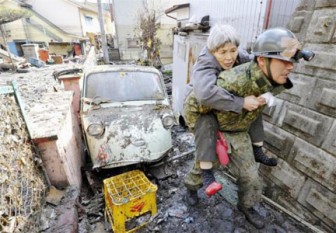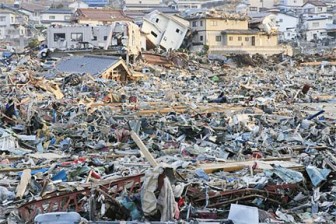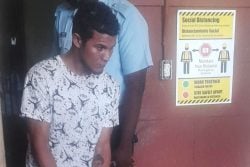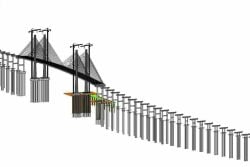FUKUSHIMA, Japan, (Reuters) – Japan battled yesterday to prevent a nuclear catastrophe and to care for millions of people without power or water in its worst crisis since World War Two, after a massive earthquake and tsunami that are feared to have killed more than 10,000 people.
A badly wounded nation has seen whole villages and towns wiped off the map by a wall of water, leaving in its wake an international humanitarian effort of epic proportions.
“The earthquake, tsunami and the nuclear incident have been the biggest crisis Japan has encountered in the 65 years since the end of World War Two,” a grim-faced Prime Minister Naoto Kan told a news conference yesterday.

“We’re under scrutiny on whether we, the Japanese people, can overcome this crisis.”
Officials confirmed three nuclear reactors north of Tokyo were at risk of overheating, raising fears of an uncontrolled radiation leak.
As Kan spoke, engineers worked desperately to cool the fuel rods in the damaged reactors. If they fail, the containers that house the core could melt, or even explode, releasing radioactive material into the atmosphere.
Kan also said the world’s third biggest economy faced rolling power blackouts when it reopens for business on Monday.
Tokyo’s financial markets will reopen, with a 0.5 percent fall in U.S. S&P futures pointing to stocks taking a hit, while the yen rallied in volatile trading on expectations of repatriations by insurers and other companies.

Broadcaster NHK, quoting a police official, said more than 10,000 people may have been killed as the wall of water triggered by Friday’s 8.9-magnitude quake surged across the coastline, reducing whole towns to rubble.
“I would like to believe that there still are survivors,” said Masaru Kudo, a soldier dispatched to Rikuzentakata, a nearly flattened town of 24,500 people in far-northern Iwate prefecture.
Kyodo news agency said 80,000 people had been evacuated from a 20-km (12-mile) radius around the stricken nuclear plant, joining more than 450,000 other evacuees from quake and tsunami-hit areas in the northeast of the main island Honshu.
Almost 2 million households were without power in the freezing north, the government said. There were about 1.4 million without running water.
“I am looking for my parents and my older brother,” Yuko Abe, 54, said in tears at an emergency centre in Rikuzentakata.
“Seeing the way the area is, I thought that perhaps they did not make it. I also cannot tell my siblings that live away that I am safe, as mobile phones and telephones are not working.”
NUCLEAR CRISIS
The most urgent crisis centres on the Fukushima Daiichi nuclear complex, where all three reactors were threatening to overheat, and where authorities said they had been forced to vent radioactive steam into the air to relieve reactor pressure.
The complex, 240 km (150 miles) north of Tokyo, was rocked by an explosion on Saturday, which blew the roof off a reactor building. The government did not rule out further blasts there but said this would not necessarily damage the reactor vessels.
Authorities have poured sea water in all three of the reactors at the complex, run by Tohoku Electric Power Co , to cool them down.
Nuclear expert Mark Hibbs of the Carnegie Endowment for International Peace said the authorities appeared to be having some success in their efforts to avert a bigger disaster, but added the situation was still “touch and go”.
“Injection of sea water into a core is an extreme measure,” he said. “this is not according to the book.”
Chief Cabinet Secretary Yukio Edano said there might have been a partial meltdown of the fuel rods at the No. 1 reactor, where Saturday’s blast took place, and there was a risk of an explosion at the building housing the No. 3 reactor, but that it was unlikely to affect the reactor core container.
A Japanese official said 22 people have been confirmed to have suffered radiation contamination and up to 190 may have been exposed. Workers in protective clothing used handheld scanners to check people arriving at evacuation centres.
“NOT ANOTHER
CHERNOBYL”
The nuclear accident, the worst since Chernobyl in Soviet Ukraine in 1986, sparked criticism that authorities were ill-prepared for such a massive quake and the threat that could pose to the country’s nuclear power industry.
Prime Minister Kan sought to allay radiation fears:
“Radiation has been released in the air, but there are no reports that a large amount was released,” Jiji news agency quoted him as saying. “This is fundamentally different from the Chernobyl accident.”
Nevertheless, France recommended its citizens leave the Tokyo region, citing the risk of further earthquakes and uncertainty about the nuclear plants.
Kan said food, water and other necessities such as blankets were being delivered by vehicles but because of damage to roads, authorities were considering air and sea transport. He also said the government was preparing to double the number of troops mobilised to 100,000.
Thousands spent another freezing night huddled in blankets over heaters in emergency shelters along the northeastern coast, a scene of devastation after the quake sent a 10-metre (33-foot) wave surging through towns and cities in the Miyagi region, including its main coastal city of Sendai.
There were also fears another powerful quake could strike, with Japan’s Meteorolo-gical Agency saying there was a 70 percent chance of an aftershock with a magnitude of 7.0 or greater in the three days from 10 a.m. (0100 GMT) yesterday.
Aftershocks in the 5 to 6 magnitude range have shaken the ground repeatedly since Friday’s huge quake.
ECONOMIC IMPACT
Already saddled with debts twice the size of its $5 trillion economy and threatened with credit downgrades, the government is discussing a temporary tax rise to fund relief work.
Analysts expect the economy to suffer a hit in the short-term, then get a boost from reconstruction activity.
“When we talk about natural disasters, we tend to see an initial sharp drop in production … then you tend to have a V-shaped rebound. But initially everyone underestimates the damage,” said Michala Marcussen, head of global economics at Societe Generale.
Ratings agency Moody’s said yesterday the fiscal impact of the earthquake would be temporary and have a limited play on whether it would downgrade Japan’s sovereign debt.
Risk modelling company AIR Worldwide said insured losses from the earthquake could reach nearly $35 billion.
The Bank of Japan is expected to pledge today to supply as much money as needed to prevent the disaster from destabilising markets and its banking system.
It is also expected to signal its readiness to ease monetary policy further if the damage from the worst quake since records began in Japan 140 years ago threatens a fragile economic recovery.




